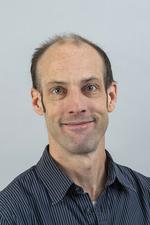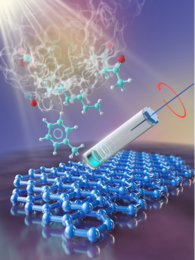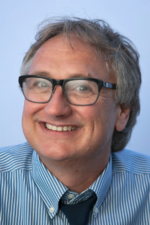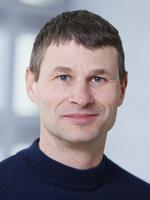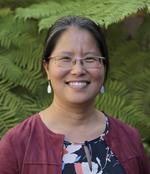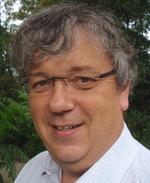This page provides information about the previous schedule of the Leipzig Spin Resonance Colloquium in autumn 2021/2022.
Leipzig Spin Resonance Colloquium Topic
Find more information in the Physics Colloquium Program.
For more information please visit the Matysik working group.
Single-spin nuclear magnetic resonance
Abstract
Nuclear magnetic resonance (NMR) spectroscopy is a powerful technique for analyzing the structure and function of molecules, and for performing three-dimensional imaging of their spin densities. At the heart of NMR spectrometers is the detection of electromagnetic radiation, in the form of a free induction decay signal, generated by nuclei precessing around an applied magnetic field. Whereas conventional NMR requires signals from 1012 or more nuclear spins, recent advances in sensitive magnetometry have dramatically lowered the required number of nuclei to a level where a few or even individual nuclear spins can be detected. It is unclear whether continuous detection of the free induction decay can still be applied at the single-spin level, or whether quantum back-action (the effect that a detector has on the measurement itself) modifies or suppresses the NMR response.
In this talk, I will discuss measurements of the “free induction decay” from single nuclear spins. Our experimental system consists of the electronic spin of a nitrogen-vacancy center in diamond that detects 13C nuclear spins in its vicinity. We observe and miminize two important effects of quantum back-action: measurement-induced decoherence and frequency synchronization with the sampling clock. Further, our measurement allows for a three-dimensional mapping of the locations of the 13C nuclei with sub-Angstrom spatial resolution. I will discuss the many hurdles on the road ahead towards structural NMR on single molecules deposited on the diamond surface.
Prof. Christian Degen
ETH Zürich, Switzerland
Christian Degen is a Professor at Department of Physics, ETH Zürich, Switzerland.
Model-free approach to the interpretation of restricted and anisotropic self-diffusion in magnetic resonance of biological tissues
Abstract
Magnetic resonance imaging (MRI) is the method of choice for noninvasive studies of micrometer-scale structures in biological tissues via their effects on the time/frequency-dependent 'restricted' and anisotropic self-diffusion of water. Traditional MRI relies on pulsed magnetic field gradients to encode the signal with information about translational motion in the direction of the gradient, which convolves fundamentally different aspects—such as bulk diffusivity, restriction, anisotropy, and flow—into a single effective observable lacking specificity to distinguish between biologically plausible microstructural scenarios. To overcome this limitation, we introduce a formal analogy between measuring rotational correlation functions and interaction tensor anisotropies in nuclear magnetic resonance (NMR) spectroscopy and investigating translational motion in MRI, which we utilize to convert data acquisition and analysis strategies from NMR of rotational dynamics in macromolecules to MRI of diffusion in biological tissues, yielding model-independent quantitative metrics reporting on relevant microstructural properties with unprecedented specificity. This lecture includes the basic physical principles of using spectrally modulated gradient waveforms to separate and correlate specific aspects of translational motion, as well as examples of applications to liquid crystals, yeast cells, tumors, and brains.
Prof. Daniel Topgaard
Lund University, Sweden
Daniel Topgaard is a Professor of Physical Chemistry at Lund University, Sweden. Following a Ph.D. degree in Lund 2003 he was a postdoctoral fellow with Alex Pines at UC Berkeley developing NMR spectroscopy for inhomogeneous fields. His current research is focused on solid-state NMR and diffusion MRI methods for investigating structure and dynamics of soft matter systems from lipid membranes to the living human brain.
Abstract
Carbon capture by adsorption onto surfaces represents one of the more promising platforms to mitigate anthropogenic emissions of carbon into the atmosphere. The design and analysis of adsorbents is informed by a molecular understanding of how CO2 interacts with these materials, particularly in the presence of water at temperatures and pressures associated with the panoply of flue gas conditions. This is particularly true in the context of direct air capture with ~420ppm of CO2. Herein I will present solid-state and pulsed field gradient NMR results that reveal the reaction and transport of CO2 in these materials, portending pilot scale studies at modest scale.
Prof. Jeffrey A. Reimer
Department of Chemical and Biomolecular Engineering
UC Berkeley
Jeffrey A Reimer’s career spans a diverse array of contributions in expanding and applying spectroscopy for materials research. Professor Reimer’s most recent scholarly works span a range of materials studies, including the structure and proprieties of metal organic frameworks for carbon capture and electrical and optical control of nuclear polarization in semiconductors. Professor Reimer is recognized for these works by election as a Fellow of the American Association for the Advancement of Science, a Fellow of the American Physical Society in the Division of Materials Physics, a Fellow of the International Society for Magnetic Resonance, and is a recipient of the Humboldt Research Award from Germany. In addition to his research publications, Professor Reimer is co-author (with T.M. Duncan) of the introductory text Chemical Engineering Design and Analysis (Cambridge University Press, 2nd edition, 2019), and the text Carbon Capture and Sequestration (with Berend Smit, Curt Oldenburg, Ian Bourg, World Scientific Press, 2013).
Professor Reimer has won virtually every teaching award on the Berkeley campus - at the department, college, physical sciences, and campus level, including the Donald Sterling Noyce Prize for Excellence in Undergraduate Teaching in the Physical Sciences, the AIChE Northern California Section Award for Chemical Engineering Excellence in Academic Teaching, and the UC Berkeley Distinguished Teaching Award in 2003, the highest award bestowed on faculty for their teaching. His introductory textbook (Chemical Engineering Design and Analysis – an Introduction co-authored with T. Michael Duncan), focuses on teaching chemical engineers about the importance of design concepts early in their academic studies.
Professor Reimer was an Associate Dean of the Graduate School at Berkeley from 2000-2005, where he was responsible for UC Berkeley’s academic reviews of its ~100 PhD granting departments. He was Chair of Berkeley’s Department of Chemical and Biomolecular Engineering from 2006-2011, and then again from 2013 to present. He has served many times as the chair of the Academic Senate subcommittee on GSI affairs, working on policies and procedures for insuring that doctoral students are prepared for the teaching profession. Finally, Professor Reimer serves as a member of the Board of Trustees for Franklin University Switzerland and served as the Chair of the Governing Board for the Council for Chemical Research in 2015.
Professor Reimer was born in Van Nuys, California and received his bachelor’s degree (with honors) from the University of California at Santa Barbara. He obtained his doctorate in chemical physics from the California Institute of Technology while working with physicists from Xerox PARC examining the chemistry and the physics of solar cell materials. Prior to his appointment at Berkeley, he conducted basic and applied research in semiconductor science and technology as a postdoctoral fellow at IBM Research in Yorktown Heights, New York. Professor Reimer lives in the Bay Area with his wife, a special education teacher, and has four adult children.
Bullet-Dynamic Nuclear Polarization and Low-field Relaxation
Abstract
The signal in nuclear magnetic resonance is very sensitive to the structure and dynamics of matter. Under ambient conditions, however, the nuclear spin polarization is small, and only 1 in 100,000 spins contributes to the NMR signal. In dissolution-dynamic nuclear polarization, nuclear spins are polarized by coupling them to electron spins at very low temperatures. This hyperpolarized solid is then dissolved with a jet of hot solvent, and the solution is transferred rapidly to a secondary magnet for liquid-state NMR. While this method has enabled a plethora of applications, we have shown that it may be advantageous to reverse the order of transfer and dissolution: In bullet-DNP, the hyperpolarized solid is transferred to the secondary magnet using pressurised gas, and dissolved only upon arrival. A successful implementation of bullet-DNP requires control over low-field relaxation during the transfer. We present the bullet-DNP methodology, and our understanding of the relevant relaxation processes.
Dr. Benno Meier
KIT, Karlsruhe, Germany
Benno Meier is head of the Helmholtz young investigator group at Karlsruhe Institute of Technology and founder of HyperSpin Scientific UG. His main scientific focuses are on overcoming the limitations of NMR by means of hyperpolarization techniques.
Diffusion weighted magnetic resonance spectroscopy – the “inside” story
Abstract
Diffusion properties of intracellular metabolites are tightly linked to the cytomorphology of their host cells and to the biochemical processes in which they participate. I’ll give some examples of how DW-MRS harnesses the compartmental and cell-type specificity of neuro-metabolites to provide a view of tissue microstructure that is complementary to that provided by DW-MRI. I’ll briefly survey some of the salient clinical applications of DW-MRS, and its potential to also provide functional and metabolic information. Finally – some notes on the DW-MRS Lorentz workshop that took place in Leiden a couple of weeks ago, mostly regarding making DW-MRS sequences, processing and modeling fully accessible to the MR community at large.
Prof. Itamar Ronen
C.J. Gorter Center for High Field MRI Research, Leiden University Medical Center, The Netherlands
Prof. Itamar Ronen obtained his PhD in Physical Chemistry from the School of Chemistry in Tel Aviv University, where he worked with Prof. Gil Navon on developing a method for indirect NMR detection of 17O. Following a post-doctoral fellowship at the Center for Magnetic Resonance Research at the University of Minnesota with Dr. Seong-Gi Kim and Dr. Dae-Shik Kim, he obtained his first academic position at the Boston University School of Medicine, and there, together with Dr. Dae-Shik Kim, he co-founded the Center for Biomedical Imaging and a Master’s degree in Bioimaging. In 2009 Itamar moved to the Netherlands, where he joined the C. J. Gorter Center for MRI at the Leiden University Medical Center as PI and Associate Professor, focusing mostly on developing methods for diffusion of intracellular metabolites in humans at ultrahigh field, and recently on developing spectroscopic techniques suitable for low field MR (0.05T). Since October 2021 he holds the positions of Academic Director of the Clinical Imaging Science Centre and Chair in Medical Physics at the Brighton and Sussex Medical School in Brighton, UK.
Where has all the coherence gone?
Abstract
Loss of electron spin coherence entails loss of resolution and sensitivity in pulse electron paramagnetic resonance (EPR) experiments and loss of polarization transfer efficiency in dynamic nuclear polarization (DNP) experiments. While the EPR community has long been careful enough to call the characteristic time of this loss a phase memory time rather than a transverse relaxation time T2, the dominating processes were still considered as memoryless relaxation and thus as irrevocable. However, application of Carr-Purcell schemes and other multiple-refocusing schemes in the context of quantum information processing demonstrated that this is not the case. Inspired by these observations on highly ordered systems with low content of magnetic nuclei, we applied such dynamical decoupling schemes to spin probes in glassy environments [1,2]. In such samples, which are typical for applications of pulsed EPR to proteins, materials, and some catalysts, we found a linear increase of decoherence time with the number of refocusing pulses. Decoherence times are shorter in aqueous environment [2] than in ortho-terphenyl [1], but the general behavior is alike. We further observed coherence loss due to vicinal methyl groups at temperatures where methyl rotation is negligible on the time scale of the EPR experiment.
We obtained insight into the causes of decoherence by introducing regularized noise spectroscopy as a means for separating loss mechanisms and understanding their timescale [3]. The Kveder, Stoll, and Goldfarb groups pursued the alternative approach of simulations by cluster correlation expansion, which also stems from the quantum information processing community. Their results indicated that a large fraction of the loss can be explained by considering a system consisting of the electron spin and two protons. We demonstrate here that electron spin echo envelope modulation (ESEEM) in this three-spin system is responsible and that a closed-form expression for such nuclear-pair ESEEM can be obtained. This in turn allows for very fast simulations, which are not quantitative, but do provide insight into general properties of proton-induced electron decoherence.
The coherence loss induced by immobile methyl groups results from another ESEEM effect, which is due to hyperfine-mediated mixing of electron spin states with tunnel-split states of the methyl quantum rotor [4]. We discuss where the coherence goes and why we can regain part of it.
References
[1] J. Soetbeer, M. Hülsmann, A. Godt, Y. Polyhach, G. Jeschke, Phys. Chem. Chem. Phys. 20, 1615-1628 (2018) Dynamical decoupling of nitroxides in o-terphenyl: a study of temperature, deuteration and concentration effects
[2] J. Soetbeer, M. Millen, K. Zouboulis, M. Hulsmann, A. Godt, Y. Polyhach, G. Jeschke, Phys. Chem. Chem. Phys. 23, 5352-5369 (2021) Dynamical decoupling in water-glycerol glasses: a comparison of nitroxides, trityl radicals and gadolinium complexes
[3] J. Soetbeer, L. Fabregas-Ibanez, Z. Berkson, Y. Polyhach, G. Jeschke, Phys. Chem. Chem. Phys. 23 21664-21676 (2021) Regularized dynamical decoupling noise spectroscopy - a decoherence descriptor for radicals in glassy matrices
[4] M. Šimėnas, D. Klose, M. Ptak, K. Aidas, M. Mączka, J. Banys, A. Pöppl, G. Jeschke, Science Advances, 6, eaba1517, (2020) Magnetic excitation and readout of methyl group tunnel coherence
Prof. Gunnar Jeschke
Department of Chemistry and Applied Biosciences, ETH Zürich, Switzerland
Dynamic Nuclear Polarization to Enhance the Detection of Wet Interfaces and Interaction
Abstract
My group uses advanced magnetic resonance tools and precise manipulation and detection of electron and nuclear spin probes located on biomolecular and materials surfaces to uncover their design rules for molecular recognition, including the surface structuring and dynamics of hydration water. Visualizing molecular interactions and materials interfaces, previously "invisible", fundamentally transform our ability to discover solutions, and almost as importantly, ask new questions. The study of local features at the nanometer and sub-nanometer scale is achieved through the use of strategically placed or intrinsically located electron spin probes and sites, and orders of magnitudes in NMR signal enhancements, achieved through the polarization transfer from the electron spin probes to the surrounding nuclear spins, relying on processes broadly termed dynamic nuclear polarization (DNP). I will present conceptual and hardware tools of DNP-amplified nuclear magnetic resonance (NMR) and electron paramagnetic resonance (EPR). I will also discuss applications of DNP and other advanced magnetic resonance tools to decipher mechanisms behind spontaneous or seeded molecular assembly.
Prof. Song-I Han
Department of Chemistry and Biochemistry; Department of Chemical Engineering, University of California Santa Barbara, Santa Barbara, CA, 93106, USA
Spin-Cavity Dynamics Beyond Radiation Damping
Abstract
Coherent backaction of a resonator on a spin system was predicted and measured early on in the development of NMR. The resonator current induced by a precessing macroscopic magnetic moment was recognized to itself generate a field that tends to rotate the spin magnetization back to its equilibrium position. The action of the reactive field is called “radiation damping”, although it does not formally contribute to thermalization. While often phenomenologically modeled as a magnetization-dependent classical drive term in modified Bloch equations, radiation damping is a result of deeper quantum mechanical dynamics of the joint spin-resonator (spin-cavity) system. As pointed out by Dicke, radiation damping may be described as a superradiant phenomenon, in analogy to experiments in quantum optics.
Recent advancements in the fabrication of high Q, small mode volume superconducting resonators have allowed precise investigations of spin-cavity physics, including regimes beyond radiation damping where longer cavity photon lifetimes lead to higher order multibody effects. We provide a review of the physics of a quantized cavity (resonator) mode interacting with an ensemble spin system through the Jaynes-Cummings and Tavis-Cummings models, and discuss how the effects of spin-cavity correlations developed during an experiment may be conveniently modeled using semiclassical Maxwell-Bloch equations. We also present recent experiments that demonstrate the effect of cavity-mediated multibody correlations on ESR spectroscopy measurements and discuss future directions for next-generation magnetic resonance quantum devices that harness the power of coherent spin-cavity dynamics.
Function-based nonadiabatic principles for artificial photosynthesis with high yield
Abstract
With Magic-angle spinning NMR, cryo-Electron microscopy, and accurate computer simulations we resolve universal mechanisms of biological photosynthesis across taxonomies and species, and study how to transfer biological design principles to chiral biomimetic nanomaterials for high yield artificial photosynthesis. Photosynthetic complexes are activated in the ground state by local mismatches that selectively enhance conformational dynamics to perform the biological functions of light harvesting, charge separation and catalysis upon excitation by light. This leads us into a function based framework of limited complexity for the design of semisynthetic and biomimetic artificial photosynthesis components for the conversion and storage of solar energy into chemicals.
